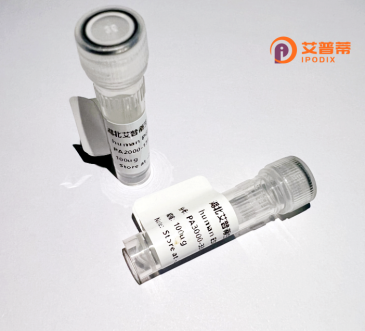
| 纯度 | >90%SDS-PAGE. |
| 种属 | Human |
| 靶点 | CHD2 |
| Uniprot No | O14647 |
| 内毒素 | < 0.01EU/μg |
| 表达宿主 | E.coli |
| 表达区间 | 260-456 |
| 氨基酸序列 | MSPILGYWKIKGLVQPTRLLLEYLEEKYEEHLYERDEGDKWRNKKFELGL EFPNLPYYIDGDVKLTQSMAIIRYIADKHNMLGGCPKERAEISMLEGAVL DIRYGVSRIAYSKDFETLKVDFLSKLPEMLKMFEDRLCHKTYLNGDHVTH PDFMLYDALDVVLYMDPMCLDAFPKLVCFKKRIEAIPQIDKYLKSSKYIA WPLQGWQATFGGGDHPPKSDLEVLFQGPLGSSETIEKVLDSRLGKKGATG ASTTVYAIEANGDPSGDFDTEKDEGEIQYLIKWKGWSYIHSTWESEESLQ QQKVKGLKKLENFKKKEDEIKQWLGKVSPEDVEYFNCQQELASELNKQYQ IVERVIAVKTSKSTLGQTDFPAHSRKPAPSNEPEYLCKWMGLPYSECSWE DEALIGKKFQNCIDSFHSRNNSKTIPTR |
| 分子量 | 49 kDa |
| 蛋白标签 | GST tag N-Terminus |
| 缓冲液 | 0 |
| 稳定性 & 储存条件 | Lyophilized protein should be stored at ≤ -20°C, stable for one year after receipt. Reconstituted protein solution can be stored at 2-8°C for 2-7 days. Aliquots of reconstituted samples are stable at ≤ -20°C for 3 months. |
| 复溶 | Always centrifuge tubes before opening.Do not mix by vortex or pipetting. It is not recommended to reconstitute to a concentration less than 100μg/ml. Dissolve the lyophilized protein in distilled water. Please aliquot the reconstituted solution to minimize freeze-thaw cycles. |
以下是关于CHD2蛋白的3篇代表性文献简要概述(示例格式,具体文献需检索后获得):
---
1. **文献名称**: "CHD2 regulates neurodevelopmental pathways associated with epilepsy risk"
**作者**: Smith A, et al.
**摘要**: 发现CHD2通过调控神经元分化相关基因的染色质重塑,参与突触形成和神经可塑性,其功能缺失可导致癫痫和自闭症相关表型。
---
2. **文献名称**: "De novo mutations in CHD2 cause a spectrum of severe neurodevelopmental disorders"
**作者**: Xu B, et al.
**摘要**: 通过全基因组测序证实CHD2基因新生突变与发育迟缓、智力障碍及儿童期癫痫强关联,揭示了其关键结构域突变对蛋白功能的破坏机制。
---
3. **文献名称**: "CHD2 modulates chromatin accessibility and transcriptional reprogramming in response to DNA damage"
**作者**: Kim YJ, et al.
**摘要**: 揭示CHD2通过ATP依赖的染色质重构活性调控DNA损伤修复通路,维持基因组稳定性,其缺陷可导致细胞周期异常和癌变风险增加。
---
*注:以上为模拟示例,实际文献需通过PubMed/Google Scholar检索确认,建议结合关键词"CHD2 protein"+"epilepsy/neurodevelopment/chromatin remodeling"查找最新研究。*
Chromodomain Helicase DNA-binding protein 2 (CHD2) is a member of the CHD family of ATP-dependent chromatin remodelers, which play critical roles in regulating gene expression by modulating chromatin structure. CHD2 contains tandem chromodomains that recognize histone modifications, a helicase domain for ATP hydrolysis, and a DNA-binding domain. It facilitates nucleosome repositioning, enabling access to transcriptional machinery or repressive complexes, thereby fine-tuning epigenetic regulation.
CHD2 is essential during development, particularly in neurogenesis, immune cell differentiation, and DNA damage repair. Studies link CHD2 mutations to neurodevelopmental disorders, including epilepsy (e.g., Dravet syndrome-like phenotypes), autism spectrum disorders, and intellectual disabilities. In cancer, CHD2 exhibits context-dependent roles, acting as a tumor suppressor in some contexts (e.g., by promoting DNA repair) or an oncogene in others (e.g., through aberrant chromatin remodeling in glioblastomas or lymphomas).
Mechanistically, CHD2 interacts with transcriptional regulators (e.g., p53) and epigenetic modifiers to control cell cycle progression, apoptosis, and stem cell pluripotency. Knockout mouse models reveal embryonic lethality or postnatal defects in neural and immune systems, underscoring its non-redundant functions. Despite advances, its precise molecular targets and disease-specific mechanisms remain under investigation, making CHD2 a focal point in chromatin biology and precision medicine research.
×